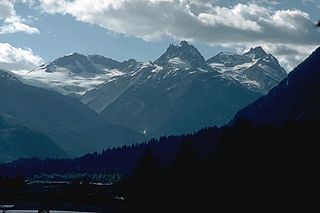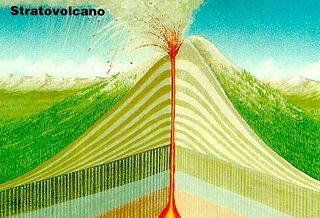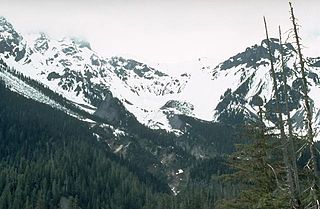
The Garibaldi Volcanic Belt is a northwest-southeast trending volcanic chain in the Pacific Ranges of the Coast Mountains that extends from Watts Point in the south to the Ha-Iltzuk Icefield in the north. This chain of volcanoes is located in southwestern British Columbia, Canada. It forms the northernmost segment of the Cascade Volcanic Arc, which includes Mount St. Helens and Mount Baker. Most volcanoes of the Garibaldi chain are dormant stratovolcanoes and subglacial volcanoes that have been eroded by glacial ice. Less common volcanic landforms include cinder cones, volcanic plugs, lava domes and calderas. These diverse formations were created by different styles of volcanic activity, including Peléan and Plinian eruptions.
The Pyramid, also called Pyramid Dome, is a young lava dome on the northeast flank of Mount Edziza in British Columbia, Canada. It is on the northeastern edge of the Tencho Glacier and represents several different styles of volcanic activity on the Mount Edziza complex. It is in the Northern Cordilleran Volcanic Province and last erupted during the Pleistocene period.
The Bridge River Cones, sometimes referred to as the Lillooet Cones and Salal Creek Cones, is the name given to a volcanic field located on the north flank of the upper Bridge River, about 40 km (25 mi) west of the town of Gold Bridge. The cones are in the lee of the Lillooet Icecap and sit astride a group of passes between the Bridge River, which flows W-E to their south, and the Lord River, which flows north to the Taseko Lakes in the Chilcotin District.

The Pemberton Volcanic Belt is an eroded Oligocene-Miocene volcanic belt at a low angle near the Mount Meager massif, British Columbia, Canada. The Garibaldi and Pemberton volcanic belts appear to merge into a single belt, although the Pemberton is older than the Garibaldi Volcanic Belt. The Pemberton Volcanic Belt is one of the geological formations comprising the Canadian Cascade Arc. It formed as a result of subduction of the former Farallon Plate.

Volcanology of Canada includes lava flows, lava plateaus, lava domes, cinder cones, stratovolcanoes, shield volcanoes, submarine volcanoes, calderas, diatremes, and maars, along with examples of more less common volcanic forms such as tuyas and subglacial mounds. It has a very complex volcanological history spanning from the Precambrian eon at least 3.11 billion years ago when this part of the North American continent began to form.

Ember Ridge is a volcanic mountain ridge associated with the Mount Cayley volcanic field in British Columbia, Canada. Ember Ridge is made of a series of steep-sided domes of glassy, complexly jointed, hornblende-phyric basalt with the most recent eruptions during the Holocene. The domes have structural similarities which indicate that the domes are similar in age and could have formed by the same foundation.

Slag Hill is a subglacial volcano associated with the Mount Cayley volcanic field in British Columbia, Canada. It consists of glassy, augite-phyric basaltic andesite in steep-sided, glassy, finely jointed domes and one small, flat-topped bluff. The finely jointed domes are similar to those of Ember Ridge. There are quench features at Slag Hill, which is suggesting that the volcanic activity was subglacial. Slag Hill was formed throughout the Pleistocene period, but its most recent volcanic activity produced a lava flow on its western lobe that shows no evidence of ice-contact volcanism. This indicates the lava flow was erupted less than 10,000 years ago after the last glacial period.
The Bennett Lake Volcanic Complex (BLVC) is a huge 50-million-year-old extinct caldera complex that spans across the British Columbia-Yukon border in Canada. It is located near the western end of the West Arm of Bennett Lake. The caldera complex is surrounded by granitic rocks containing pendants.

The Powder Mountain Icefield, also called the Powder Mountain Icecap and the Cayley Icefield, is a glacial field in the Pacific Ranges of southwestern British Columbia, Canada, about 20 kilometres (12 mi) west of Whistler and about 90 kilometres (56 mi) north of Vancouver. On the west side of the icefield is the valley of the Squamish River, while on its east is the Callaghan Valley, which is the setting for the Nordic facilities for the 2010 Winter Olympics.

The Back River volcanic complex is an Archean stratovolcano spanning the Northwest Territories–Nunavut border in Northern Canada. It is located 480 kilometres (298 mi) northwest of Yellowknife and to the northwest of the Back River from which it takes its name. The volcano constitutes the Back Group of the Yellowknife Supergroup and is somewhat anomalous in the Slave craton because it has undergone only a low degree of deformation and is subhorizontal. The southern half of the complex is exposed at the crest of a small dome. This is the eroded portion of the stratovolcano that has been preserved in an upright position. The complex comprises four volcanic sedimentary sequences that correspond to the phases of growth and destruction of this stratovolcano.

Pali Dome is a subglacial volcano in the Pacific Ranges of the Coast Mountains in southwestern British Columbia, Canada. It is part of the Mount Cayley volcanic field and its elevation is 2,250 m (7,380 ft). For the past 2 million years, the Mount Cayley volcanic field has had interactions between ice and lava which have created some unique landforms and an in-ice drainage system."Pali" comes from the Hawaiian word that means cliff or steep hill, while dome refers to the lava dome, which is when doughy lava flows from a volcanic vent which is usually rounded and flat on top.
Triangle Dome is a trachytic lava dome in northern British Columbia, Canada. It is thought to have formed in the Pleistocene period.
Sezill Volcano is a lava dome in Mount Edziza Provincial Park of northern British Columbia, Canada. It is thought to have formed and last erupted during the Miocene period. The volcano gets its name from being adjacent to Sezill Creek.

The Mandalagan volcano is located at latitude 10.65° North (10°39'0"N), longitude 123.25° East (123°15'0"E), in the province of Negros Occidental, on the north of the island of Negros of the Philippines. It is located inside the Northern Negros Natural Park.

Round Mountain is a mountain in northwestern British Columbia, Canada, located 22 km (14 mi) east of Dease Lake.
Pharaoh Dome is a lava dome in northwestern British Columbia, Canada, located near Mount Edziza in Mount Edziza Provincial Park. It last erupted during the Pleistocene epoch.
Chakatah Creek Peak is a subglacial mound in northwestern British Columbia, Canada. It is one of the volcanoes of the Northern Cordilleran Volcanic Province and last erupted in the Pleistocene period.

The Plinth Assemblage, also known as the Plinth Formation, is an accreted terrane of igneous rocks in southwestern British Columbia, Canada, located just north of the Lillooet River and on the northern flank of the Mount Meager massif. It is named after Plinth Peak, a peak made of Plinth Assemblage rocks.













